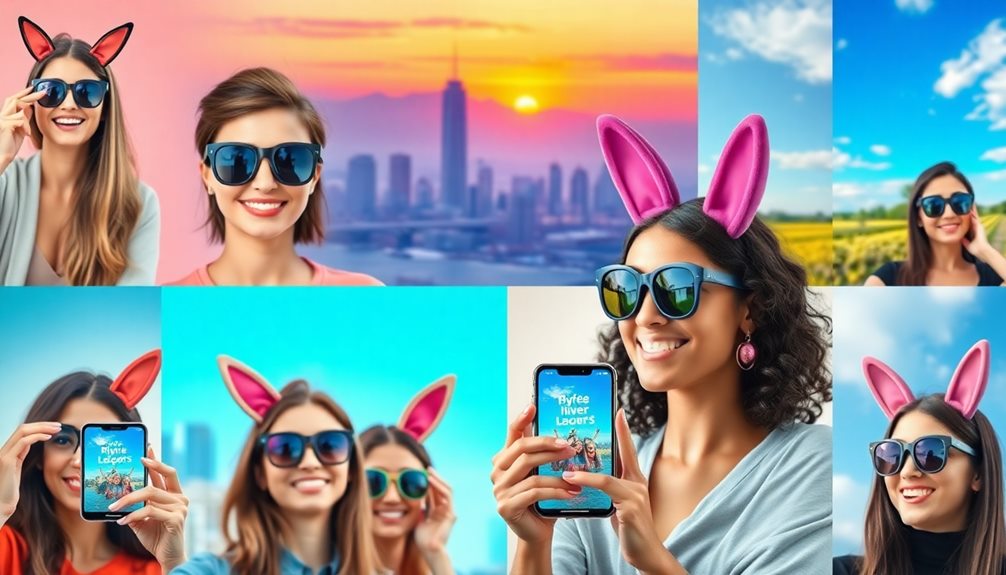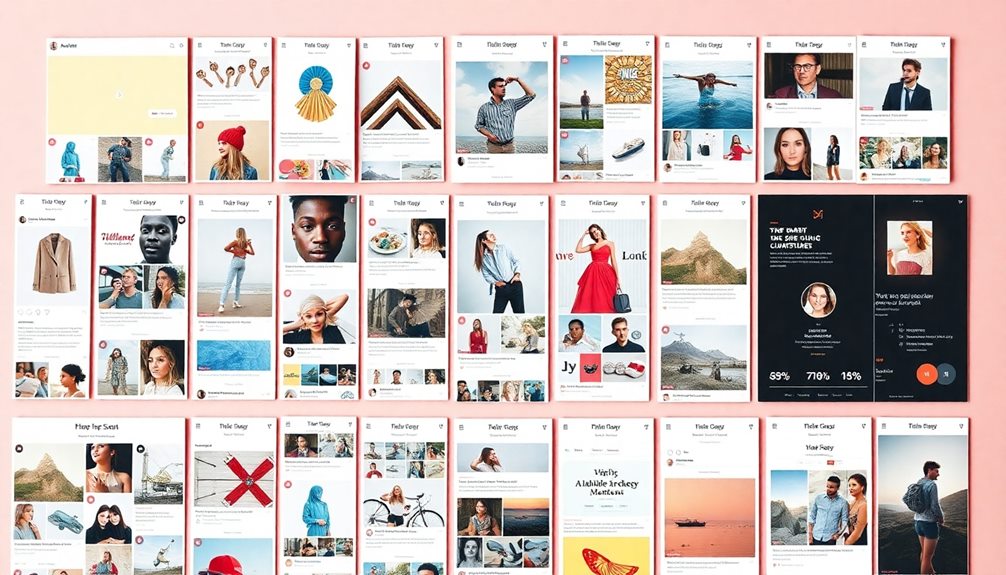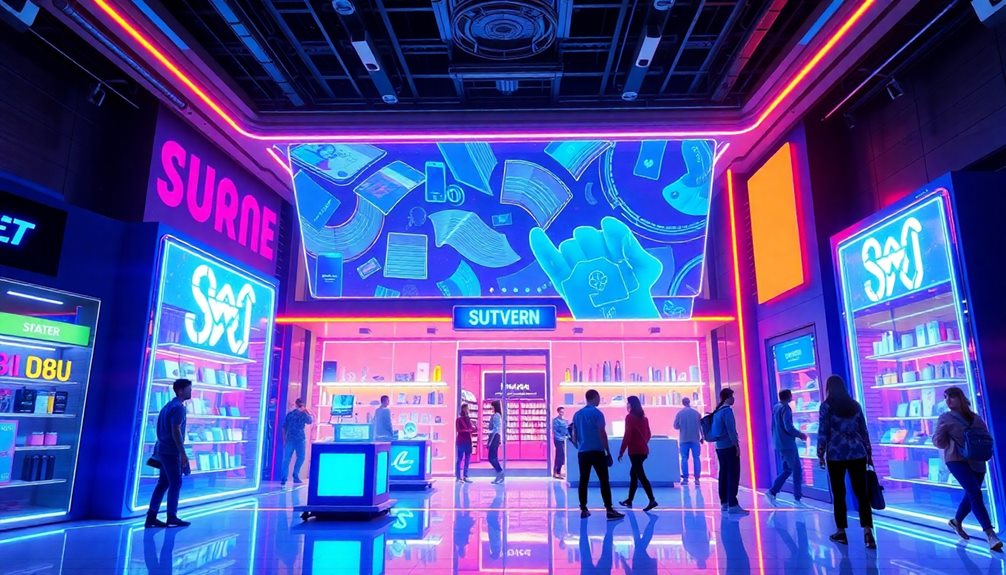AR filters are game-changers for your marketing strategy. They enhance engagement by overlaying interactive elements on social media, creating memorable experiences that connect emotionally with consumers. Brands like Warby Parker have successfully used AR for virtual try-ons, dramatically boosting conversion rates. About 79% of consumers prefer engaging with AR before making a purchase, showcasing its impact on decision-making. By targeting demographics like Gen Z, who actively seek these experiences, you can achieve better results. Explore how to develop effective campaigns and measure their success with AR filters to see the full potential of this innovative marketing tool.
Key Takeaways
- AR filters enhance engagement by offering interactive experiences, leading to a 41% increase in consumer consideration for brands.
- Targeting Gen Z effectively, AR filters align with their preference for creativity and emotional connections, boosting brand loyalty.
- Collaborating with influencers significantly increases brand visibility and user interaction, resulting in higher engagement rates.
- Measuring effectiveness through metrics like dwell time and conversion rates helps refine AR marketing strategies for better performance.
- The integration of AR in e-commerce enhances shopping experiences, leading to informed purchasing decisions and increased conversion rates.
Understanding AR Filters

AR filters are innovative tools that enhance your social media experience by overlaying virtual elements on your videos. Since their introduction in 2017 by Instagram, AR filters have transformed how you engage with content. Unlike preset filters that merely adjust images, AR filters provide interactive experiences that captivate your audience and foster emotional connections.
This interactivity is essential for brands aiming to develop meaningful relationships with their customers. As brands increasingly leverage AI tools for tailored recommendations, the potential for AR filters to create personalized experiences becomes even more substantial.
With AR filters, brands can craft customized experiences that align with their marketing strategies. For instance, you might see virtual try-ons for clothing or makeup, making the shopping experience more immersive and enjoyable. Additionally, these filters can notably boost brand awareness and drive sales by turning everyday social media interactions into memorable moments.
Using tools like Spark AR, brands can create unique filters tailored to their identity and target demographic. Plus, with analytics available to track the performance of these AR filters, you can gain valuable insights into audience engagement and campaign effectiveness.
This data empowers you to refine your marketing strategies and maximize your impact on social media.
AR Filters vs. Preset Filters
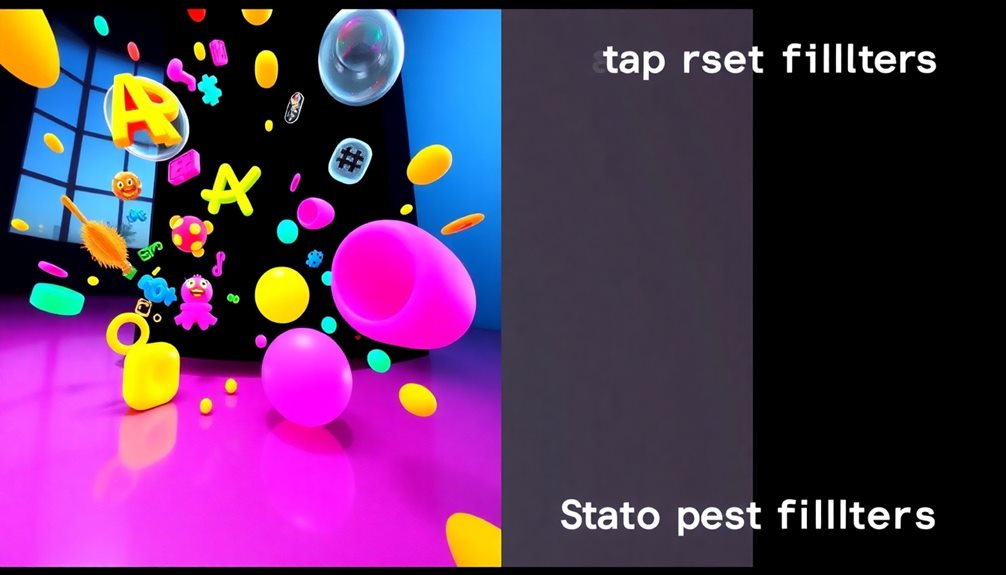
When comparing AR filters to preset filters, it's clear that the former offers a more dynamic and engaging experience. AR filters are specifically designed for video content, incorporating animations and interactive elements that foster user engagement. In contrast, preset filters simply adjust the lighting and color of still images, providing static enhancements without the immersive features AR filters bring.
Here's a quick comparison:
| Feature | AR Filters | Preset Filters |
|---|---|---|
| Engagement | High (interactive) | Low (static) |
| Content Type | Video (Instagram Stories, Reels) | Photos (various platforms) |
| User Participation | Real-time interaction | No active engagement |
| Emotional Connection | Stronger (immersive experience) | Weaker (visual enhancement) |
| Marketing Effectiveness | Higher engagement rates | Lower engagement rates |
With their interactive nature, AR filters greatly boost user engagement, making them a more effective choice for marketing campaigns. Brands can connect with their audience on a deeper level, creating memorable experiences that resonate, unlike traditional preset filters that merely enhance visuals.
Benefits of AR Filters for Brands
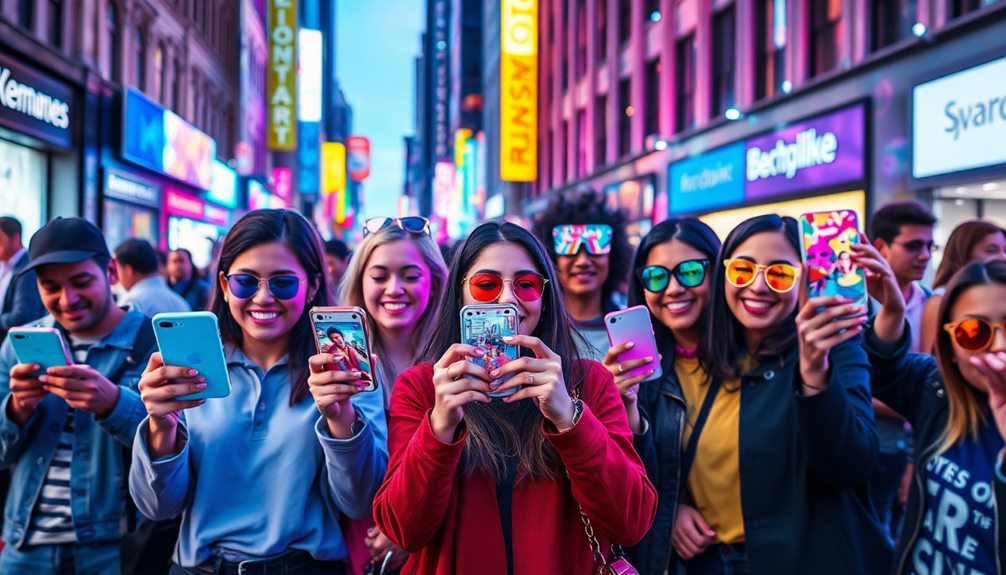
Utilizing AR filters offers brands a unique opportunity to enhance their marketing strategies. These immersive experiences can considerably increase brand awareness, with brands experiencing a 41% increase in consideration and a 94% higher conversion rate compared to traditional advertising methods.
When you implement AR filters, you can expect an average dwell time of 75 seconds, keeping users engaged far longer than other marketing channels. In addition, as seen in the recent trends in Microsoft's service disruptions, leveraging technology can create innovative marketing solutions that adapt to changing consumer behaviors.
Moreover, around 79% of consumers are interested in engaging with AR product experiences before making a purchase, indicating that these tools are effective in driving sales. Successful AR campaigns can also generate millions of organic impressions, making them a cost-effective solution with viral potential.
Additionally, leveraging AR filters helps build customer loyalty and sets your brand apart from competitors. In fact, four out of five brands report enhanced sales due to their use.
By embracing AR filters, you're not just enhancing your marketing; you're creating a memorable experience that resonates with your audience, fostering connections that translate into lasting relationships and increased revenue.
Don't miss out on the transformative benefits these tools can bring to your brand.
Engaging Gen Z With AR
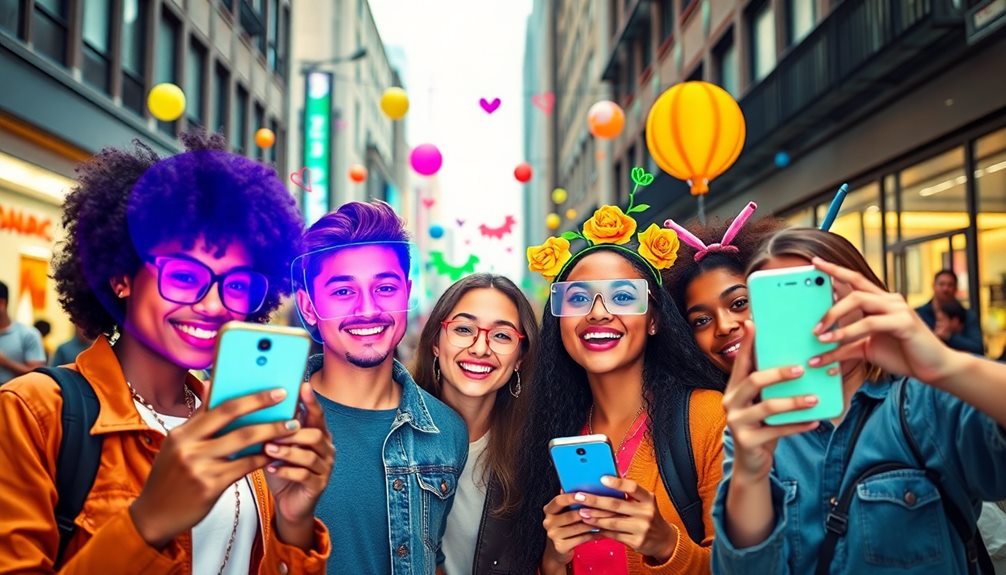
In today's digital landscape, engaging Gen Z requires more than just traditional marketing tactics; brands need to harness the power of interactive experiences. AR filters are a perfect way to capture their attention and resonate with their visual-oriented preferences. With 62% of US Gen Z users regularly using filters in their social media posts, it's clear they crave enhanced digital experiences.
By incorporating elements of effective public speaking techniques into your storytelling, you can create a more compelling narrative around your AR campaigns.
By incorporating AR filters into your marketing strategy, you can engage consumers on a deeper level. A whopping 51% of Gen Z consumers are more likely to interact with advertisements that utilize AR technology, demonstrating its effectiveness in engaging this demographic.
These interactive experiences foster emotional connections between users and brands, which is essential for building brand loyalty.
Moreover, brands leveraging AR filters not only enhance recall but also see a higher likelihood of engaging with Gen Z. As you create campaigns, remember that Gen Z values creativity and authenticity.
Creating Effective AR Campaigns
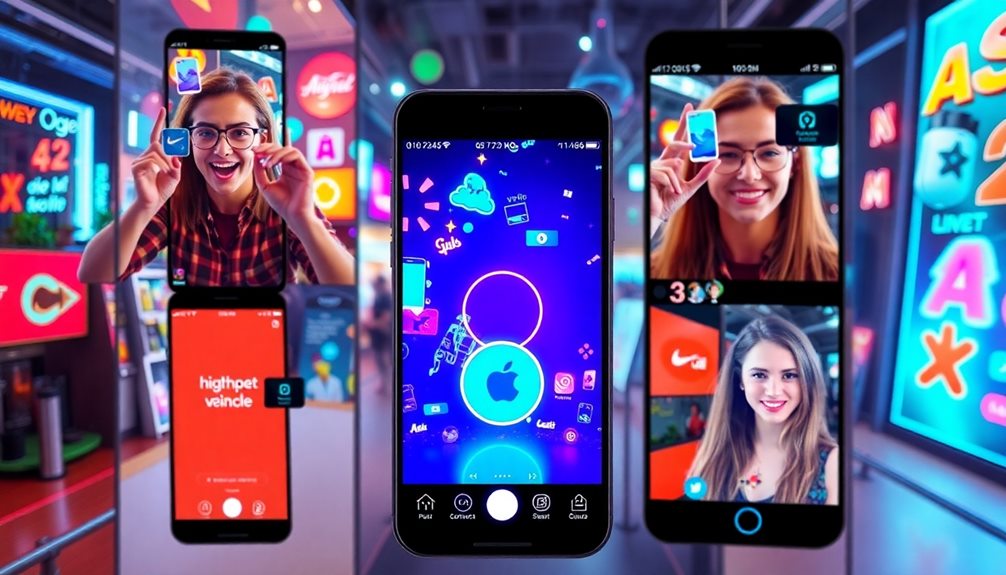
To create effective AR campaigns, you need to start by defining your campaign objectives and identifying your target audience.
Understanding who you want to reach will guide your design choices and messaging.
Don't forget to promote your filters through influencers to expand your reach and boost engagement.
Define Campaign Objectives
Setting clear campaign objectives is essential for creating effective AR campaigns that resonate with your audience. When you define your campaign objectives, whether it's increasing brand awareness or driving sales, you guide the design and implementation of AR filters that truly connect with users.
Aligning these objectives with your brand's specific goals is critical, especially since 41% of brands using AR report an increase in consumer consideration.
To track your campaign's performance, establish measurable KPIs related to your objectives. This way, you can make adjustments as needed to enhance your campaign's outcomes.
Keep in mind that understanding consumer behavior is important. For instance, 51% of Gen Z are more likely to engage with ads incorporating AR, making it essential to craft engaging AR filters that captivate this demographic.
Additionally, weaving a compelling narrative around your AR filter can greatly boost user engagement. Studies show that AR campaigns average 75 seconds of dwell time, far surpassing traditional channels.
Target Audience Identification
Understanding your target audience is essential for creating effective AR campaigns. By honing in on target audience identification, you can design AR filters that resonate with specific demographics. This is especially true for Gen Z, who thrive on interactive content. With 62% of US Gen Z regularly using filters in their social media posts, aligning your AR filters with their preferences can markedly enhance your campaign's visibility and effectiveness.
Start by setting clear campaign objectives, such as increasing brand awareness or driving sales. This clarity will guide your choices in selecting the right AR features and narratives that appeal to your audience, ultimately boosting engagement rates.
Additionally, keep track of audience interaction metrics from your AR filters. These insights will reveal preferences and behaviors, enabling you to refine your strategies for better alignment with consumer interests.
While influencer collaborations can amplify your reach, focusing on who your audience is and what they want will lay a strong foundation for your AR campaigns. By prioritizing target audience identification, you'll create engaging experiences that capture attention and foster meaningful connections.
Promote Through Influencers
Leveraging influencer partnerships can dramatically boost the effectiveness of your AR filter campaigns. With 62% of US Gen Z using filters in their social media posts, influencers can amplify your reach and engagement considerably. By collaborating with them, you can craft compelling narratives around your AR filters, ensuring they resonate with their audience's preferences.
Here's a quick overview of the benefits of promoting AR filters through influencers:
| Benefits | Details | Impact |
|---|---|---|
| Brand Visibility | Increases exposure to new audiences | Enhanced recognition |
| Engagement | Drives user interaction and shares | Higher engagement rates |
| User-Generated Content | Fosters authentic content creation | Strengthens community ties |
| Measurable Insights | Tracks performance metrics | Informed strategy adjustments |
Promoting AR filters through influencers not only enhances your brand visibility but also fosters user-generated content, further solidifying brand-influencer partnerships. Brands have reported a 41% increase in consideration when AR experiences are included in campaigns. Utilize analytics tools to measure the impact of your influencer collaborations, and watch your AR filter campaigns thrive.
Case Studies of Successful AR Use
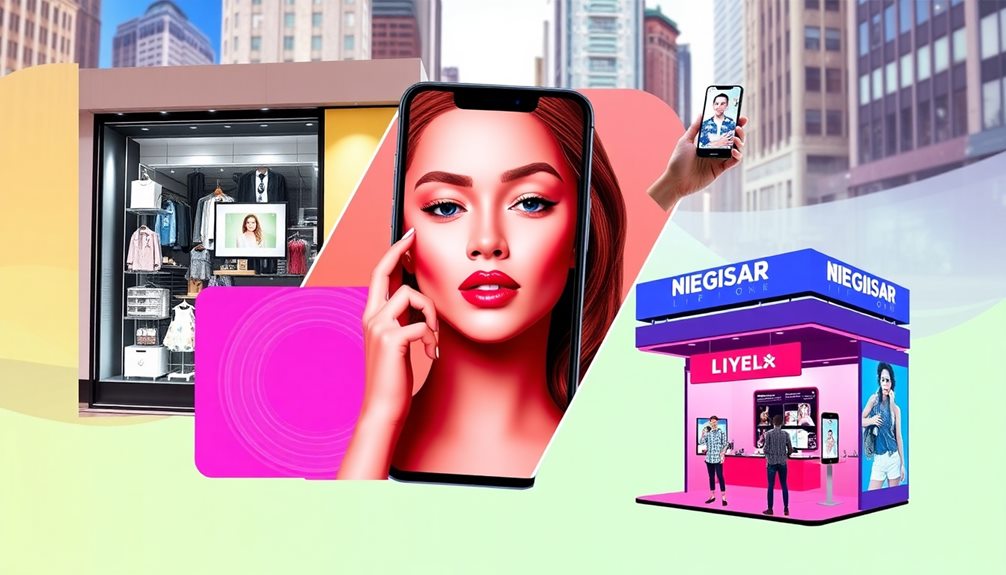
Augmented reality (AR) has emerged as a powerful marketing tool, and various brands are showcasing its potential through innovative campaigns.
For instance, SKIMS successfully utilized AR filters to enhance brand awareness, resulting in increased interaction rates and significant boosts in visibility through influencer collaborations.
Warby Parker also tapped into AR by allowing customers to virtually try on glasses, which led to higher engagement and conversion rates as users interacted with the brand in a memorable way.
Charlotte Tilbury launched an interactive makeup tutorial filter for Space NK, educating consumers while driving traffic and sales through immersive experiences.
Ford's creative approach with an interactive game filter boosted awareness for new models, encouraging users to engage playfully with the brand.
Finally, Conforama's AR filter enabled users to visualize furniture in their own homes, enhancing user engagement and sparking interest in their products during promotional campaigns.
These case studies illustrate how AR filters can create unique experiences that not only engage users but also encourage brands to embrace innovative strategies that drive sales.
Metrics for Measuring Effectiveness
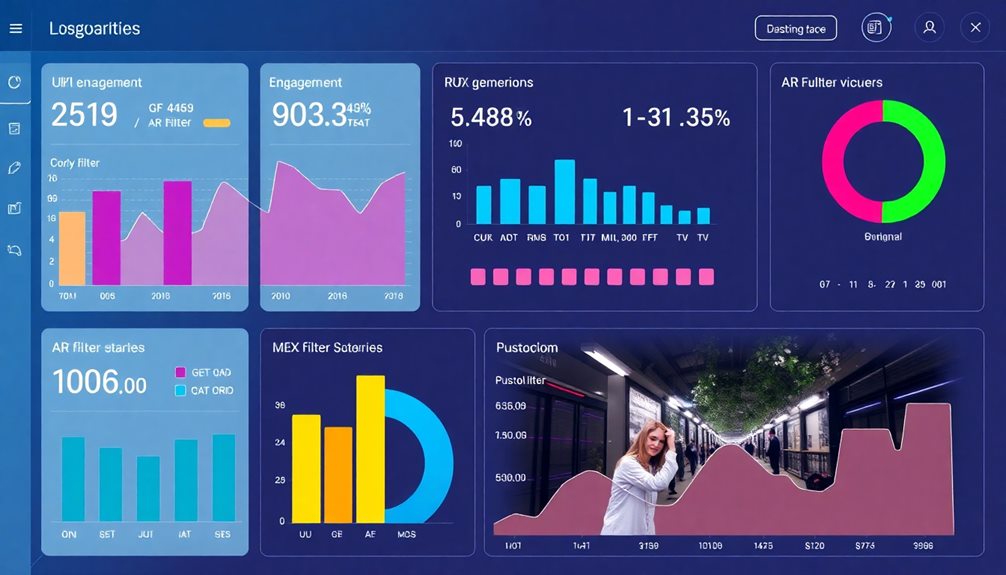
Measuring the effectiveness of AR filter campaigns requires a keen focus on specific performance metrics. By analyzing these metrics, you can determine how well your AR filters are performing and their impact on your overall marketing strategy.
Here are some essential metrics to take into account:
- Views: The number of times users interact with your AR filter can indicate its reach and popularity.
- Average Dwell Time: With users averaging 75 seconds of engagement, tracking this can help you assess user interest and interaction.
- Conversion Rate: The 94% higher conversion rate reported by brands using AR filters shows their potential to drive sales compared to traditional methods.
Utilizing analytics tools enables you to track these performance metrics effectively. You'll get valuable insights into user interactions that can guide you in refining and optimizing future campaigns.
Ultimately, focusing on these metrics allows you to harness the full power of AR filters, making them a cost-effective marketing tool that can notably increase brand consideration and engagement.
Future Trends in AR Marketing
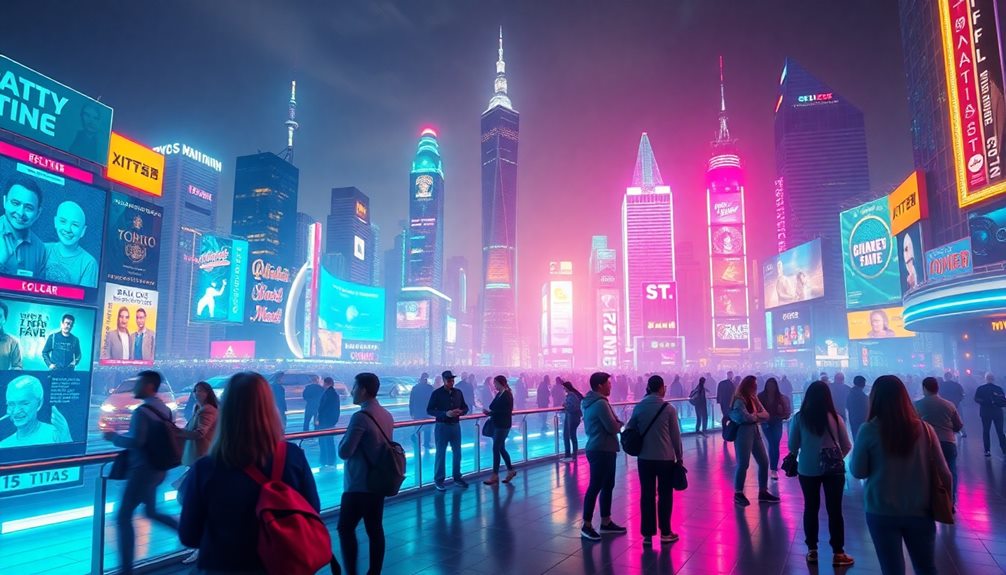
As AR technology evolves, you'll see a significant rise in e-commerce integration, making shopping experiences more interactive and engaging.
Enhanced user interaction won't only boost brand loyalty but also create personalized journeys for consumers.
This shift will redefine how you connect with your audience and drive conversions in the coming years.
E-commerce Integration Growth
The future of e-commerce is set to be transformed by the rapid growth of AR filters, creating a more immersive shopping experience for consumers. As you explore online shopping, expect to virtually try on products, which could boost conversion rates by up to 94%.
With around 75% of the population projected to be frequent AR users by 2025, the market for brands to integrate AR into their platforms is expanding rapidly.
Here are some key benefits of incorporating AR filters in e-commerce:
- Enhanced Product Visualization: AR allows customers to see how products fit into their lives before making a purchase.
- Increased Customer Engagement: Brands using AR filters can experience a 41% boost in brand consideration, keeping customers more interested.
- Competitive Advantage: As AR technology evolves, embracing these tools is vital to stand out in the crowded e-commerce landscape.
With the AR market estimated to reach $60 billion by 2023, investing in AR filters isn't just a trend—it's an essential step for enhancing customer engagement and staying competitive in the future of e-commerce.
Enhanced User Interaction
AR filters are revolutionizing how brands interact with consumers, moving beyond simple product visualization to create memorable and engaging experiences. These immersive tools are increasingly integrated into e-commerce, allowing you to virtually "try before you buy." Imagine seeing how a piece of furniture fits in your living room or how a lipstick shade complements your skin tone—it's a game changer.
By 2025, as 75% of the global population becomes frequent AR users, brands will need to adopt immersive marketing strategies to stand out. The statistics speak for themselves; brands using AR filters enjoy a staggering 94% higher conversion rate compared to traditional advertising. This shows the power of interactive experiences in driving sales and fostering deeper user engagement.
As AR technology continues to evolve, you'll see brands push boundaries with innovative campaigns designed to create emotional connections. By leveraging AR filters, companies can capture your attention in ways that resonate, ensuring they stay competitive in a rapidly changing digital landscape.
Get ready for a future where your shopping experience isn't just transactional but interactive and enjoyable, all thanks to the magic of AR.
Cost Considerations for AR Filters
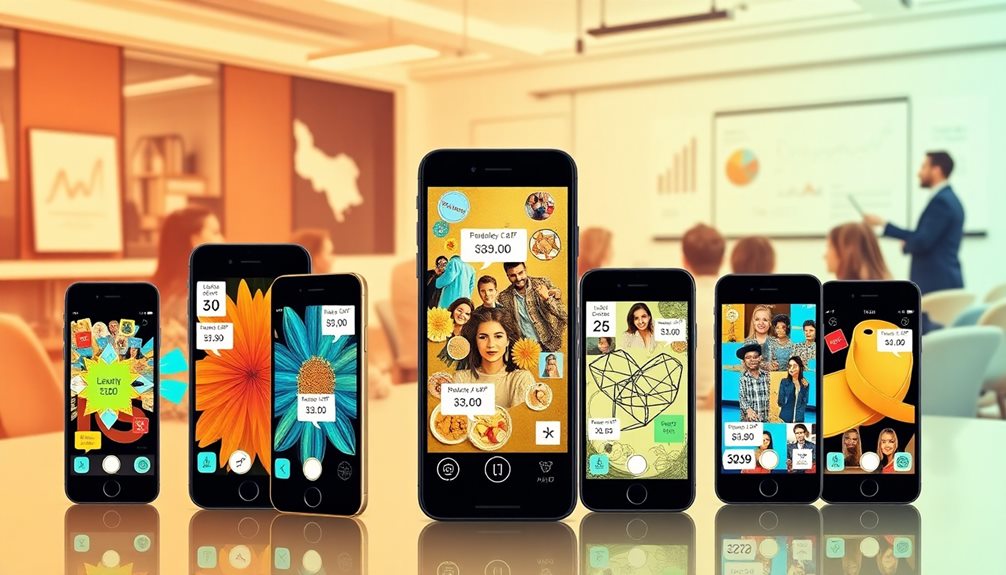
While creating AR filters can seem challenging, understanding the cost considerations can simplify the process. The investment for AR filters varies widely. You might spend nothing on simple designs, while more complex projects can run between $2,000 and $20,000, depending on features and functionalities.
AR filters offer a cost-effective alternative to traditional marketing methods. Consider these points:
- High engagement: Successful AR filters average a 33-second view time, making them far more engaging than standard social media ads.
- Organic reach: With the potential for millions of views without paid advertising, AR filters can boost visibility considerably.
- Favorable CPM: Instagram's cost-per-thousand impressions (CPM) is around $7.91, making AR filters a budget-friendly marketing strategy.
Ultimately, brands leveraging AR filters often see impressive returns on investment, with increases in consideration by 41% and conversion rates soaring up to 94%.
Best Practices for Implementation

Understanding cost considerations lays the groundwork for effective implementation of AR filters in your marketing strategy. Start by setting clear campaign objectives, whether it's boosting brand awareness or driving sales. This focus guides your filter design and promotional efforts.
Collaborating with influencers is another powerful tactic; their established audiences can considerably amplify your campaign's reach and engagement.
Promote your AR filters across various social media platforms to encourage user-generated content. This approach not only enhances your brand visibility but also fosters community interaction around the filter experience.
Remember, 62% of US Gen Z actively use filters in their posts, so encouraging users to share their experiences can create a viral effect, further increasing organic reach.
Lastly, utilize analytics tools to track performance metrics like views and shares. This data allows you to adjust your strategies in real-time and evaluate the effectiveness of your AR campaigns.
Frequently Asked Questions
How Do AR Filters Impact User Privacy and Data Security?
AR filters can raise concerns about user privacy and data security. When you use them, your camera and personal data might be accessed, leading to potential misuse if companies don't implement proper security measures or transparency.
What Platforms Support AR Filter Creation and Deployment?
Imagine a painter with a vibrant canvas. Platforms like Instagram, Snapchat, and Facebook serve as your palette, letting you create and share AR filters, transforming everyday moments into colorful experiences that captivate your audience.
Can AR Filters Be Used Offline or Require Internet Access?
AR filters typically require internet access to function properly, as they rely on cloud processing and data retrieval. However, some apps allow limited offline use, but you'll miss out on full features and updates.
How Can Brands Customize AR Filters to Match Their Identity?
Imagine your brand's colors bursting to life. You can customize AR filters by incorporating your logo, unique visuals, and brand tone. This way, you create an engaging experience that resonates with your audience, capturing their attention.
What Skills ARe Needed to Create Effective AR Filters?
To create effective AR filters, you'll need design skills, coding knowledge, and an understanding of user experience. Familiarity with 3D modeling and animation tools also helps you bring your creative ideas to life seamlessly.
Conclusion
In the ever-evolving world of marketing, AR filters aren't just a trend; they're a powerful tool that can elevate your brand. Imagine a vibrant garden where each flower represents a unique AR experience, attracting the attention of Gen Z and beyond. By embracing these interactive filters, you'll not only engage your audience but also stay ahead of the competition. So, immerse yourself in AR, and watch your brand bloom in ways you never thought possible.
